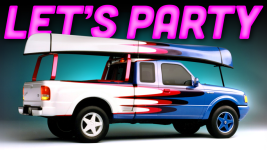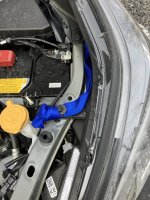Good discussion here. Well, sounds like folks with newer cars are managing one way or another, which somewhat relieves my apprehensions. Still going to keep my current car on the road as long as possible.
As far as the age-old bow-lines debate, I have successfully transported solos and tandems up to 16ft at 'local higway' speeds i.e. up to 60ish without bowlines many times. I have definitely had yaw from semis passing and crosswinds on interstates (and going thru Keene Valley in the Adks last year).
Since I'm currently sporting homemade crossbars out of 2x3s, I've decided to pretty much always use bowlines even locally (tho even going to my closest flatwater spots I hit 60mph on the local highway), mostly in case of a wreck. I don't want my boat going thru someone else's windshield if my bars or main straps fail. It's a bit of belt and suspenders overkill most of the time, but you almost never need a seatbelt or PFD either....until you do. I do make exceptions for the local creek which I get to on real backroads, don't exceed 40mph, and rarely have on-coming traffic.
On the interstate with a longer boat (16ft) I'll add a line from the stern to the trunk door, using a very improvised hunk of 2x2 thru a loop shut in the trunk. It irks me greatly that my generation of Forester has no good tie-points on the back end. I could bolt loops with grommets to the inside trunk door frame (currently use them on the biw) but I don't need the stern tie often enough to bother.
As far as the age-old bow-lines debate, I have successfully transported solos and tandems up to 16ft at 'local higway' speeds i.e. up to 60ish without bowlines many times. I have definitely had yaw from semis passing and crosswinds on interstates (and going thru Keene Valley in the Adks last year).
Since I'm currently sporting homemade crossbars out of 2x3s, I've decided to pretty much always use bowlines even locally (tho even going to my closest flatwater spots I hit 60mph on the local highway), mostly in case of a wreck. I don't want my boat going thru someone else's windshield if my bars or main straps fail. It's a bit of belt and suspenders overkill most of the time, but you almost never need a seatbelt or PFD either....until you do. I do make exceptions for the local creek which I get to on real backroads, don't exceed 40mph, and rarely have on-coming traffic.
On the interstate with a longer boat (16ft) I'll add a line from the stern to the trunk door, using a very improvised hunk of 2x2 thru a loop shut in the trunk. It irks me greatly that my generation of Forester has no good tie-points on the back end. I could bolt loops with grommets to the inside trunk door frame (currently use them on the biw) but I don't need the stern tie often enough to bother.


